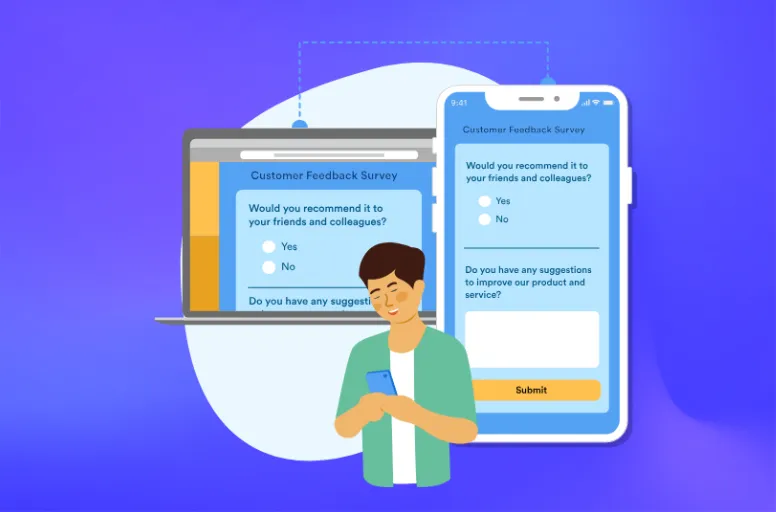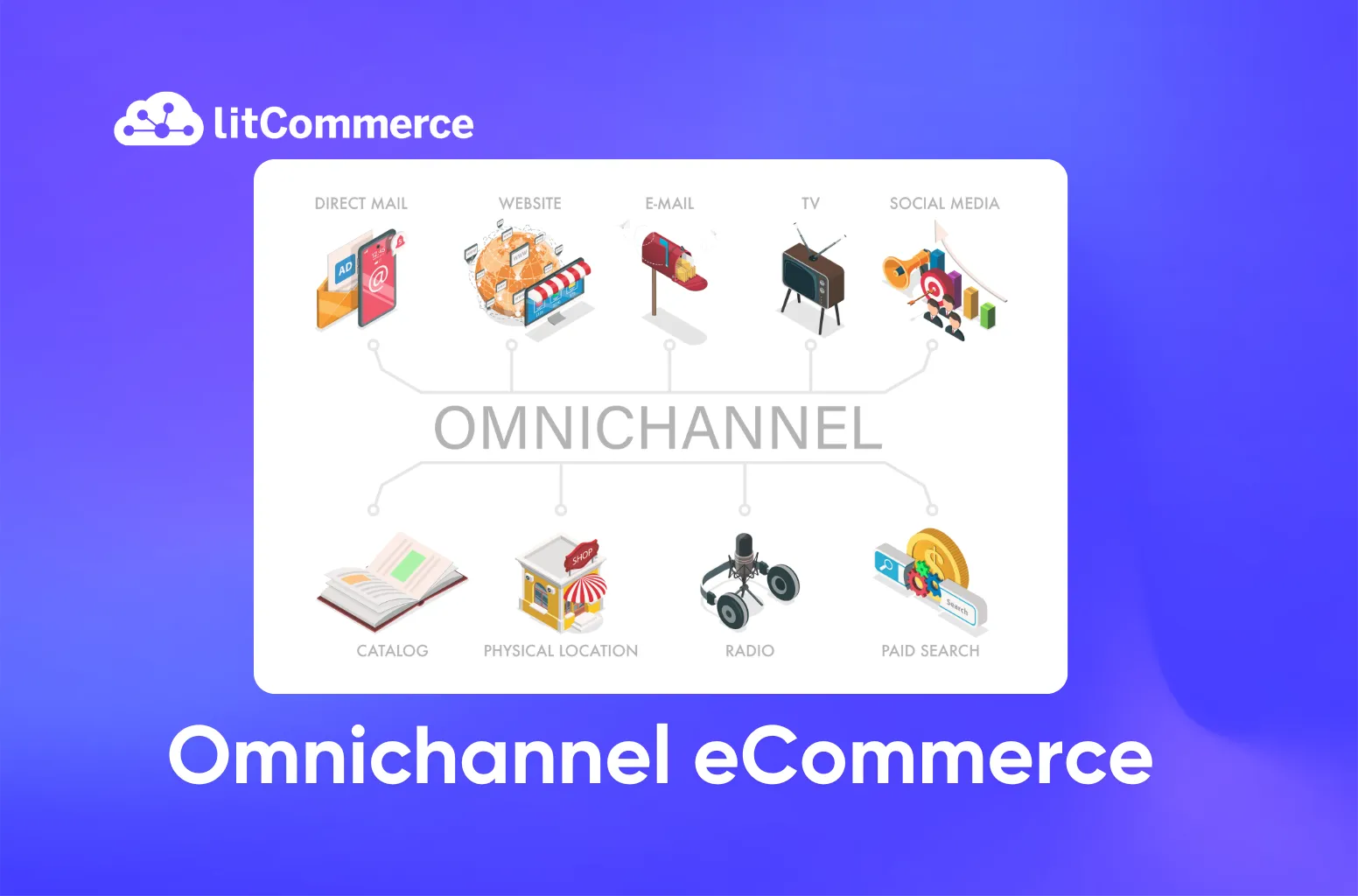Omnichannel eCommerce is a retail strategy that provides customers with a smooth shopping experience across various channels. The goal is to create a unified experience where customers can easily switch between channels without interruptions or inconsistencies.
Basically, to say, it’s about connecting all touchpoints to offer a consistent and personalized customer journey. However, how can you do that effectively? This guide is made to help! You can find helpful information here about:
- Difference between Omnichannel and Multichannel eCommerce;
- Daunting challenges with Omnichannel for eCommerce;
- How to create an effective Omnichannel eCommerce strategy;
- Predictions on Omnichannel eCommerce trends in 2024-2025.
Difference Between Omnichannel and Multichannel eCommerce
Before digging deeper into how you can make an effective eCommerce Omnichannel strategy, let’s be clear about 2 terms: Omnichannel and Multichannel.
While omnichannel and multichannel eCommerce might seem alike, they offer different customer experiences. To clarify the difference between these two terms and prevent confusion, let’s break it down with a simple comparison chart.
Omnichannel | Multichannel | |
Definition | ‣ Integrates all channels for a unified shopping experience. | ‣ Uses multiple channels so customers can shop, but they may operate independently without much integration |
Target audience | ‣ All customers, regardless of preferred channel. | ‣ Customers who use specific channels. |
Data integration | ‣ High level of data integration across all channels for a unified customer view. | ‣ Limited data integration. Customer data may be siloed across channels. |
Customer experience | ‣ Consistent and personalized experience across all touchpoints. | ‣ Experience may vary depending on the channel used. |
Data synchronization | ‣ Real-time data synchronization across all channels. | ‣ Data may be synchronized periodically or not at all. |
Customer journey | ‣ Focuses on the overall customer journey across all channels. | ‣ Focuses on individual touchpoints within each channel. |
Do you intend to start a multichannel selling model? Check out this multichannel selling guide for tips and strategies.
Why Omnichannel eCommerce is Important for Businesses?
1. Better customer experience
A seamless omnichannel experience enhances customer satisfaction by providing consistent interactions across all touchpoints. When customers have positive experiences, they are more likely to become loyal advocates for the brand, leading to increased customer lifetime value. Satisfied customers make repeat purchases, refer friends and family, and are less price-sensitive.
2. Increased sales and revenue
Omnichannel for eCommerce increases sales by providing a seamless shopping experience across multiple channels. Customers can browse products online, make purchases in-store, or use mobile apps. This consistency enhances customer satisfaction and loyalty, leading to increased repeat purchases and higher average order values.
3. Consistent brand exposure
Omnichannel eCommerce helps create a unified and consistent brand image across all platforms. Customers should have a similar experience whether they are shopping online, in-store, or through a mobile app. A strong brand identity builds trust and loyalty, making it more likely for customers to choose your business over competitors.
4. Personalized experience for your customers
Omnichannel platforms enable businesses to collect valuable customer data from every touchpoint. It could be purchase history, browsing behavior, and preferences. By analyzing this information, companies can deliver tailored content, product recommendations, and offers. Personalized experiences make customers feel valued and increase the likelihood of conversions.
5. Centralized order management
Omnichannel eCommerce simplifies order management by providing a centralized view of all customer interactions and transactions. This allows businesses to efficiently process orders, track inventory, and manage returns across different channels. Streamlined order management reduces errors, improves customer satisfaction, and increases operational efficiency.
Read more: Multichannel order management guide if you need more methods to simplify the process.
6. Improved inventory management
In an omnichannel strategy, if you can centralize inventory data, you’ll have real-time visibility into orders coming in from all sales channels. By having a clear overview of stock levels across all sales channels, you can avoid stockouts and overstocks. Accurate inventory data helps optimize product placement, reduce shipping costs, and ensure customer satisfaction.
Five Daunting Challenges with Omnichannel for eCommerce
While omnichannel eCommerce offers many advantages, it also presents some significant challenges. Successfully managing multiple channels requires careful planning and execution.
1. The need for unified customer data management
A key part of omnichannel eCommerce is providing consistent customer support, no matter how customers reach out—whether by online shopping, social media, or in-person at a store. For example, a customer might find a product online, ask questions on Instagram, and then buy it in-store. If the information isn’t synced across all channels, it can cause confusion and frustrate the customer.
2. Inventory management issues
Retail businesses building an omnichannel experience need to keep an accurate, real-time view of their stock across all sales channels. For example, a product might appear available online but could actually be out of stock due to delays in updating inventory. This can result in lost sales and a poor customer experience. Hence, the sellers should find a ways to effectively track omnichannel inventory to ensure they have clear visibility of their stock across all channels.

3. Channel conflicts
Channel conflicts in omnichannel eCommerce occur when different sales channels, such as online stores, physical retail locations, or third-party marketplaces, compete against each other. This can lead to issues like inconsistent pricing, competing promotions, and customer confusion. For example, offering lower prices online than in-store can frustrate brick-and-mortar partners. These conflicts can damage relationships with partners, create internal friction, and harm the overall customer experience.
4. Competitive pricing pressure
Omnichannel eCommerce increases pricing competition, as customers can quickly compare prices across different platforms. This pushes businesses to keep their prices consistent and competitive across all channels. However, balancing this is tough because each channel has different costs and profit margins. If prices aren’t aligned, customers might choose competitors with lower prices. But constantly lowering prices to match competitors can hurt profits. So, businesses need to carefully plan their pricing to stay competitive without losing money.
5. Customer support challenges
A key part of omnichannel eCommerce is making sure customers get the same level of support, whether they contact customer service by email, social media, or in person at a store. For example, a customer might discover a product online, ask questions on Facebook, and then buy it in-store. If customer service isn’t coordinated across channels, it can confuse and leave customers frustrated.
How to Create an Effective Omnichannel eCommerce Strategy
Building an effective eCommerce Omnichannel strategy is essential for businesses aiming to provide a seamless and integrated shopping experience. By aligning all sales channels and touchpoints, you can create a cohesive brand presence that meets customer expectations and drives business growth. Here’s how to create a successful omnichannel strategy.
1 – Conduct an in-depth analysis of your targeted customers
The foundation of any effective omnichannel strategy begins with a deep understanding of your customers. Conduct thorough research to identify their preferences, shopping habits, pain points, and preferred channels. This analysis will help you customize your approach to meet the unique needs of your target audience, ensuring that your strategy resonates with them and encourages engagement. Here are some ways you can gain some information of your targeted customers:
- Create online surveys and questionnaires: For example, you could send an email list survey asking, “Where did you first hear about our products?” This can help you identify the best touchpoints to promote your items.
- Analyze customer feedback: Pay close attention to comments, reviews, and social media mentions. Identify recurring themes and sentiments to understand customer pain points and desires.

2 – Map the customer journey
After gathering all the essential data about your target customers, you can start mapping their journey. This includes visualizing the steps they take from first becoming aware of your brand to purchasing and beyond.
To do so, looking at their behavior at each stage helps you identify opportunities to improve their experience, address pain points, and create a more seamless journey. For example, if you find that many customers drop off after adding items to their cart, you can focus on optimizing the checkout process to reduce friction.
By mapping out these interactions, you can better align your marketing, sales, and customer service efforts to guide customers smoothly through their journey. That ultimately leads to higher satisfaction and loyalty.
3 – Choose the right channels to sell on
Not all channels will be equally effective for your business, so it’s important to carefully select the ones that align with your goals and audience. When deciding how to connect with your customers, it’s easy to go with what you’re familiar with. However, the key is to choose the channels your customers prefer.
Begin by understanding your target audience and their favorite channels. You can use data like age, interests, and survey responses to identify the messaging platforms they like best.
For example, if your data shows that a large portion of your target audience is between the ages of 18 and 25 and has a strong interest in fashion, you might discover that they spend most of their time on platforms like Instagram or TikTok. By focusing your efforts on these social media platforms, you can engage with your audience where they’re active and more likely to purchase.
4 – Ensure consistent branding
A consistent brand identity is essential for building trust and loyalty. Your brand should have a recognizable look, feel, and message across all touchpoints, from your website to your physical stores. This creates a seamless customer experience that fosters familiarity and affinity.
To achieve this, implement an omnichannel marketing strategy that ensures your brand’s presence is consistent and recognizable across different platforms. Remember, a unified brand image is crucial for building trust and driving customer purchases.
5 – Invest in technology
Technology can help execute a successful omnichannel strategy. Investing in the right tools, such as inventory management software, customer relationship management (CRM) systems, and data analytics platforms, will help you manage and integrate your channels more effectively.
Especially if you sell on various online platforms, LitCommerce is an example of a powerful tool that can help you seamlessly integrate and manage multiple sales channels from a single platform. That makes it easier to streamline operations and enhance the customer experience.
6 – Optimize fulfillment and logistics
Efficient fulfillment and logistics are essential to delivering a positive omnichannel eCommerce experience. Optimize your supply chain to ensure that orders are fulfilled quickly and accurately, regardless of the channel through which they were placed. This may involve investing in centralized inventory systems, improving warehouse operations, and partnering with reliable shipping providers to meet customer expectations for speed and reliability.
7 – Personalize customer interaction
Personalized interactions increase customers’ engagement and loyalty to your brand. By using customer data, your business can offer personalized product suggestions, targeted promotions, and custom content across various channels.
For example, you can customize the content for returning visitors by tracking customer activity on your website through cookies or login data. If a customer often shops or browses the “women’s outerwear” section, you can highlight more products from that category on the homepage.
8 – Train your employees
Your employees deliver a seamless omnichannel experience, so investing in their training is essential. Some basic things you should include in the training session are knowledge about your products, the technology you use, and the capability of providing consistent service across all channels. Well-trained employees can effectively address customer inquiries, resolve issues, and deliver a cohesive brand experience, whether they’re interacting with customers online, over the phone, or in person.

Predictions on Omnichannel eCommerce Trends in 2024-2025
In 2024-2025, we can expect new trends to emerge that will reshape how businesses engage with customers across various channels. Here’s a look at some key predictions for the future of omnichannel eCommerce.
- Shopping is getting personal
Customers expect a personal touch. You can use data to understand your shoppers and offer products they’ll love. Dynamic pricing based on customer behavior can also boost profits.
- Shopping is happening everywhere
Social media isn’t just for sharing; it’s for selling too. You can sell on social media channels to Make it easy for customers to buy directly from your social posts. Plus, it’s popular recently to partner with influencers to reach a wider audience and boost sales.
- Shopping is getting more real
Let customers see your products in action. You can offer virtual try-on experiences for clothing, accessories, and even makeup. to let them visualize products in their own space. Immersive experiences can make your brand stand out.
Omnichannel for eCommerce – FAQs
Omnichannel is crucial in eCommerce as it provides a unified customer experience across all platforms. This builds trust and loyalty, encouraging customers to purchase more frequently. Sephora is a prime example of omnichannel commerce. They seamlessly blend the online and offline shopping experience, creating a unified customer journey. Customers can browse products online, read reviews, watch tutorials, and even virtually try on makeup. They can then choose to buy online for delivery or pick up in-store. In-store, customers can access online product information, earn loyalty points, and return online purchases. Omnichannel eCommerce boosts sales by offering convenience and flexibility. Customers can shop when and where they prefer, increasing their purchase chances. It also allows for personalized recommendations based on their overall behavior, not just on one channel.
Don’t You Dare Hit or Miss This?
Developing an omnichannel eCommerce strategy isn’t just about staying trendy—it’s about meeting and surpassing customer expectations in a more connected world. As more brands discover the advantages of omnichannel, they’re enhancing both online and offline channels to boost customer service. Transitioning from a single-channel or multichannel to an omnichannel approach will be worth your time and effort. Ready to start your omnichannel eCommerce strategy?
If you search for more omnichannel selling guides, visit our Blog to find more helpful articles that you may find interesting. Don’t hesitate to contact us if you need any instant support!



